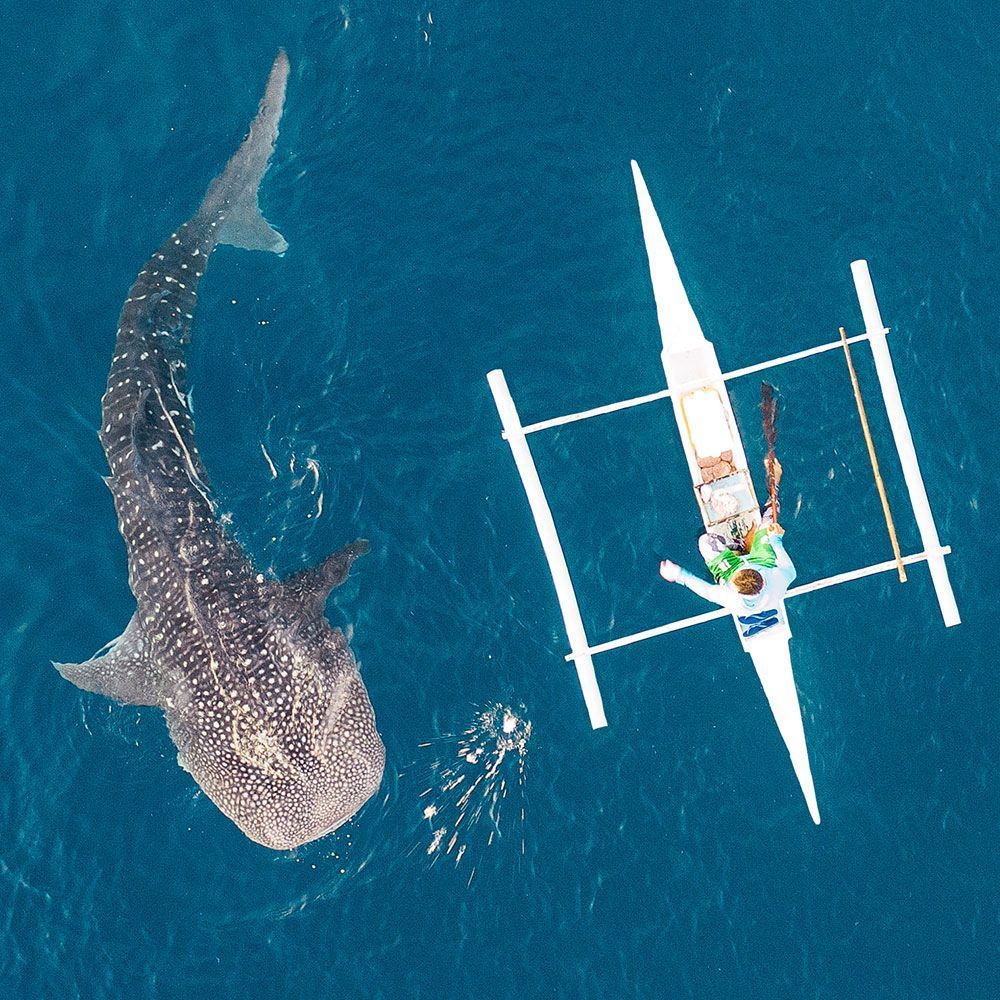Which is the biggest fish in the world?
The whale shark is the biggest fish in the world, with a recorded size of 59 feet and a maximum weight of 21.5 tons. It was tracked around 1994-1996 by Scott A. Eckert and Brent S. Stewart.
Do you know that the biggest fish to have ever lived on this planet during prehistoric times was the extinct Leedsichthys genus of fish?
The genus existed only during the Middle Jurassic period to the Cretaceous period. Some claimed that it used to be 30 m (98 ft) long. Eventually, it was known that the aquatic giant was known to be 16.5 m long – even smaller than the present-day record-holding whale shark!
But in this article, we’ll mainly focus on the top 10 biggest living fish of the present age. So, let’s not chit-chat about the past and move forth into the main agenda!
According to the latest estimates, the oceans house more than 3 trillion fish. And out of those, many majestic big species are actually competing for the biggest fish position. So, let’s take a quick peek into all of them here!
| Fish Name (Scientific Name) | Size | Weight | Natural Habitat |
|---|---|---|---|
| Whale Shark (Rhynocodon typus) | Up to 59 ft | 21.5 tons (43,000 lbs) | Atlantic Ocean, Indian Ocean, western and central Pacific Ocean, Red Sea |
| Basking Shark (Cetorhinus maximus) | Up to 40.3 ft | 9 tons (18,000 lbs) | Nova Scotia and New Brunswick coasts, north and south Pacific Ocean, north and south Atlantic Ocean, Mediterranean Sea, around New Zealand, off southern Australia, the Sea of Japan |
| Oarfish (Regalecus glesne) | Up to 36 ft | 0.3tons (600 lbs) | Atlantic Ocean, Mediterranean, and east Pacific Ocean: Chile, Topanga beach (southern California) |
| Giant Oceanic Manta Ray (Mobula birostris) | Up to 30 ft length; up to 29 ft disc width | 2.65 tons (5300 lbs) | Western Atlantic: South Carolina, Bermuda, USA, Brazil, and Uruguay; Northwestern Atlantic: Canada; Western Pacific: New Ireland, Papua New Guinea, near Palomino Islets, Peru, Lima |
| Tiger Shark (Galeocerdo cuvier) | Up to 24 ft | 3.1 tons (6,200 lbs) | Central Pacific Ocean islands, Japan, India, Indonesia, Mediterranean Sea, Africa, Australia, New Zealand |
| Beluga Sturgeon (Huso huso) | Up to 23.6 ft | 1.73 tons (3,460 lbs) | Black Sea, Sea of Azov, the Caspian seas |
| Great White Shark (Carcharodon carcharias) | Up to 21 ft | 3.5-3.66 tons (7,000-7,328 lbs) | California, northeast US, South Africa (especially Long Island), Chile, Oceania, Japan, Sea of Marmara, Bosphorus |
| Reef Manta Ray (Mobula alfredi) | Up to 18 ft disc size | 1.4 ton (1270 lbs) | East-Atlantic, Indo-Pacific Oceans: Fiji, Hawaii, Bali, French Polynesia, Maldives, Philippines, Australia, Mozambique |
| Atlantic Blue Marlin (Makaira nigricans) | Up to 16.4 ft | 0.9 ton (1800 lbs) | Atlantic Ocean, Gulf of Mexico, Caribbean Islands, Bahamas, Venezuela, Virgin Islands, West Africa |
| Black Marlin (Istiompax indica) | Up to 15 ft 3 in | 0.83-1 ton (1,650-2000 lbs) | Indo-Pacific subtropical and tropical regions, Atlantic Ocean |
1. Whale Shark (Rhynocodon typus)
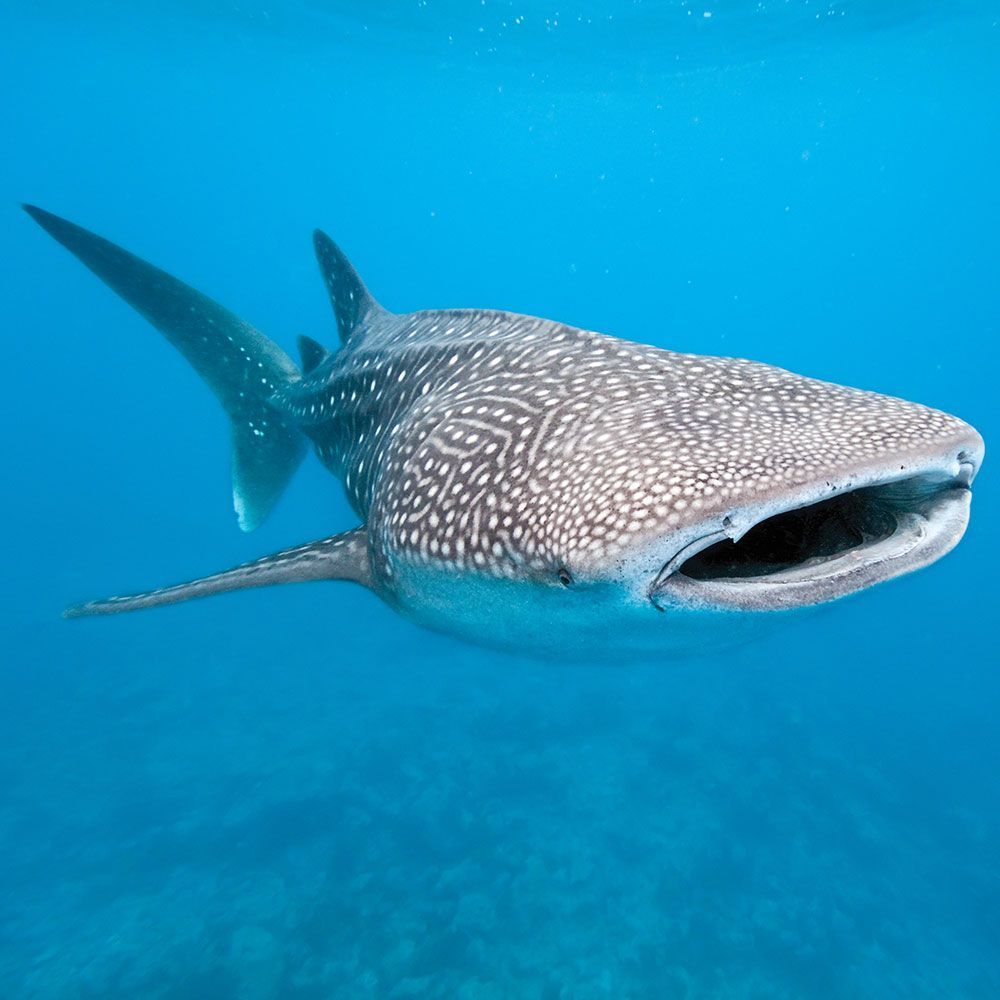
The peaceful whale shark species of the Rhinocodontidae family is known for holding the top record on this list, with a maximum size of up to 59 ft – recorded between the years 1994-1996 by Scott A. Eckert and Brent S. Stewart.
But the record weight of up to 21.5 tons (47,000 lbs) was of a 41.5 ft long specimen caught off the Pakistan coast, 1947.
The “Endangered” species is a filter feeder that lives on plankton and small fish. The migratory species are found in a vast range of tropical, warm temperate, deep, and shallow coastal regions – like the Atlantic Ocean, western and central Pacific Ocean, Indian Ocean, and the Red Sea.
It has a streamlined blue-green body with white spots and a checkered pattern on the back, a broad flat head, a large mouth, a truncated snout, small teeth, and keels on both sides of the head.
Whale sharks are known to have existed 100 million years ago – during the early Permian to early Triassic periods.
2. Basking Shark (Cetorhinus maximus)
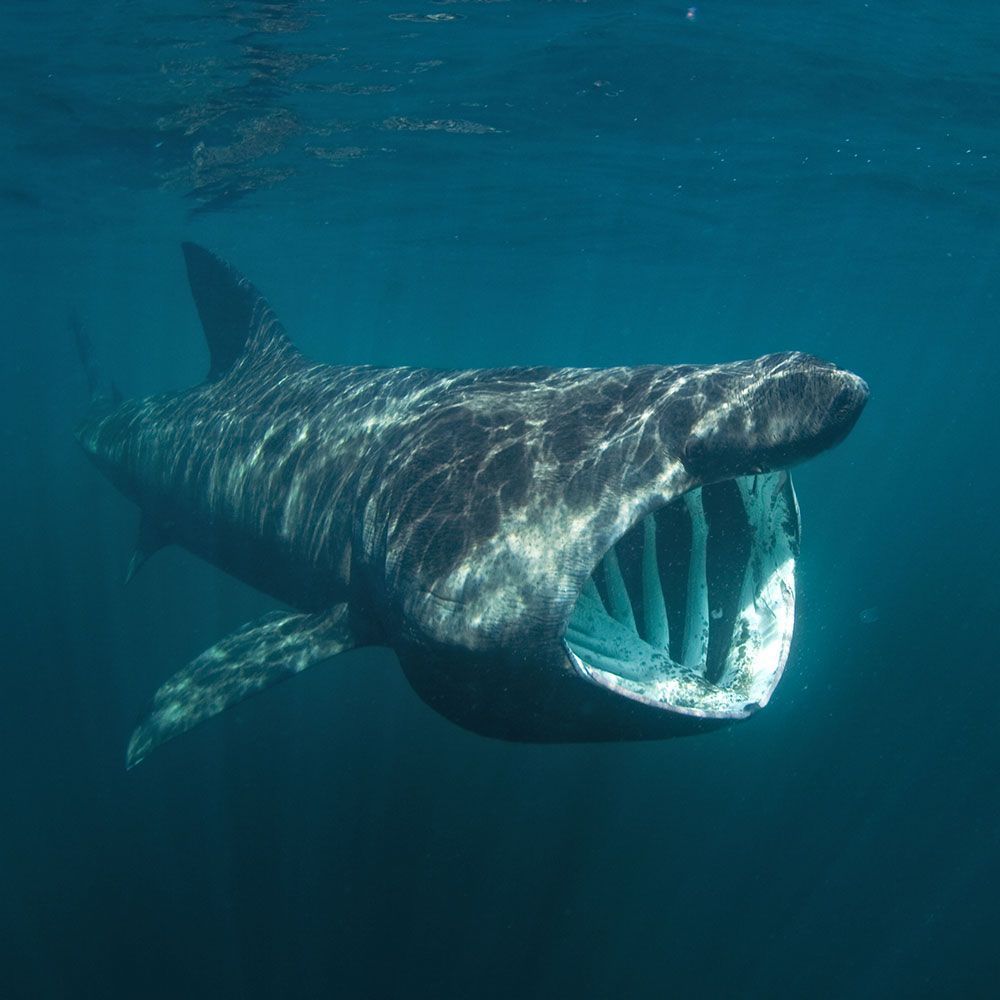
The only living member of the Cetorhinidae family, the passive and harmless species, is reportedly the second largest shark and fish till now. Its record size and weight was a whopping 40.3 ft and 9 tons (19,900 lbs), found in the Bay of Fundy, Canada, 1851.
The omnivorous zooplankton-lover greyish-brown mottled-skinned basking shark has a white mouth and a crescent-shaped tail fin with a pronounced lateral keel.
This “Vulnerable” pelagic species is usually found in the north and south Atlantic Ocean, the north and south Pacific Ocean, the Sea of Japan, the Mediterranean Sea, around New Zealand, and off southern Australia.
It also roams 200-2000m deep waters and is often spotted on the coasts of Nova Scotia and New Brunswick – especially during summer and spring.
Though so big, this shark gets attacked by cookie-cutter sharks, white sharks, and killer whales.
3. Oarfish (Regalecus glesne)
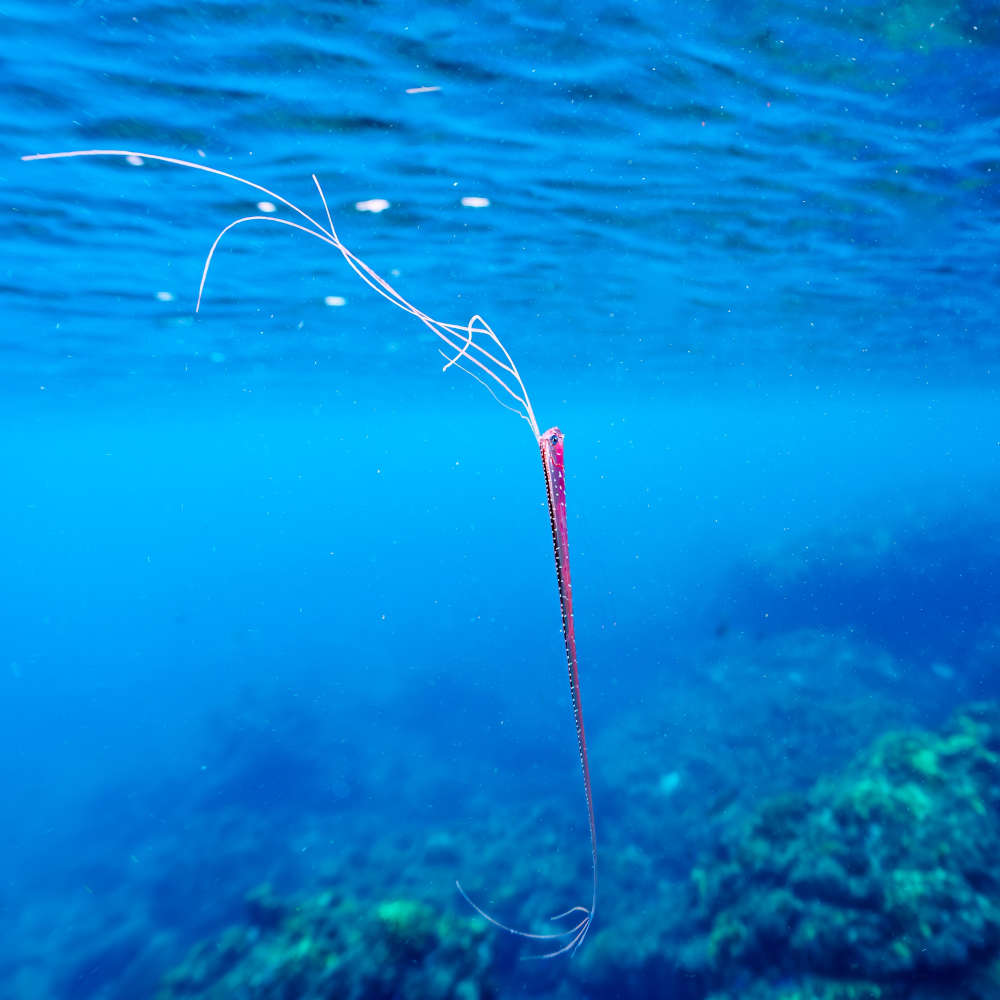
The unique ribbon-like oarfish holds this position with its record length of 36 ft and 272 kg (600 lbs). The silvery blue, dark-spotted fish has a dorsal fin along the total length, long and oar-like pelvic fins, and stubby pectoral fins.
Belonging to the Regalecidae family, the fish was first identified in 1772 by Peter Ascanius. It’s known to feast on plankton, squid, crustaceans, and krills.
The fish is observed in the tropics and middle latitudes, presumably in epipelagic to mesopelagic regions. Widely spotted in the Atlantic Ocean, Mediterranean, and east Pacific Ocean: Topanga Beach (southern California) to Chile.
The fish holds the title of the longest bony fish alive in the world, according to the Guinness Book of World Records.
4. Giant Oceanic Manta Ray (Mobula birostris)

The docile, filter-feeding carnivore has a flattened, broad head, a terminal mouth, long head fins, denticles on its top surface, and a spineless tail. It’s black above, white below, and has white shoulder patches. It’s spotted solo and even in groups of up to 50.
The popular species from the Molubidae family is known to grow up to 30 ft with a disc width of up to 29 ft and 2.65 tons (5300 lbs).
The species is spotted in oceanic tropics, subtropics, and temperates. Namely, it’s noticed in South Carolina, Bermuda, the USA, Brazil, and Uruguay (western Atlantic), Canada (northwestern Atlantic), New Ireland, Papua New Guinea (western Pacific), and around Palomino Islets, Peru, Lima.
Giant oceanic manta rays are known to have a common swimming speed of 14.5 km/h (9 miles/hour). But when faced with danger, it can pick a speed of up to 35.4 km/h (22.5 miles/hour).
5. Tiger Shark (Galeocerdo cuvier)
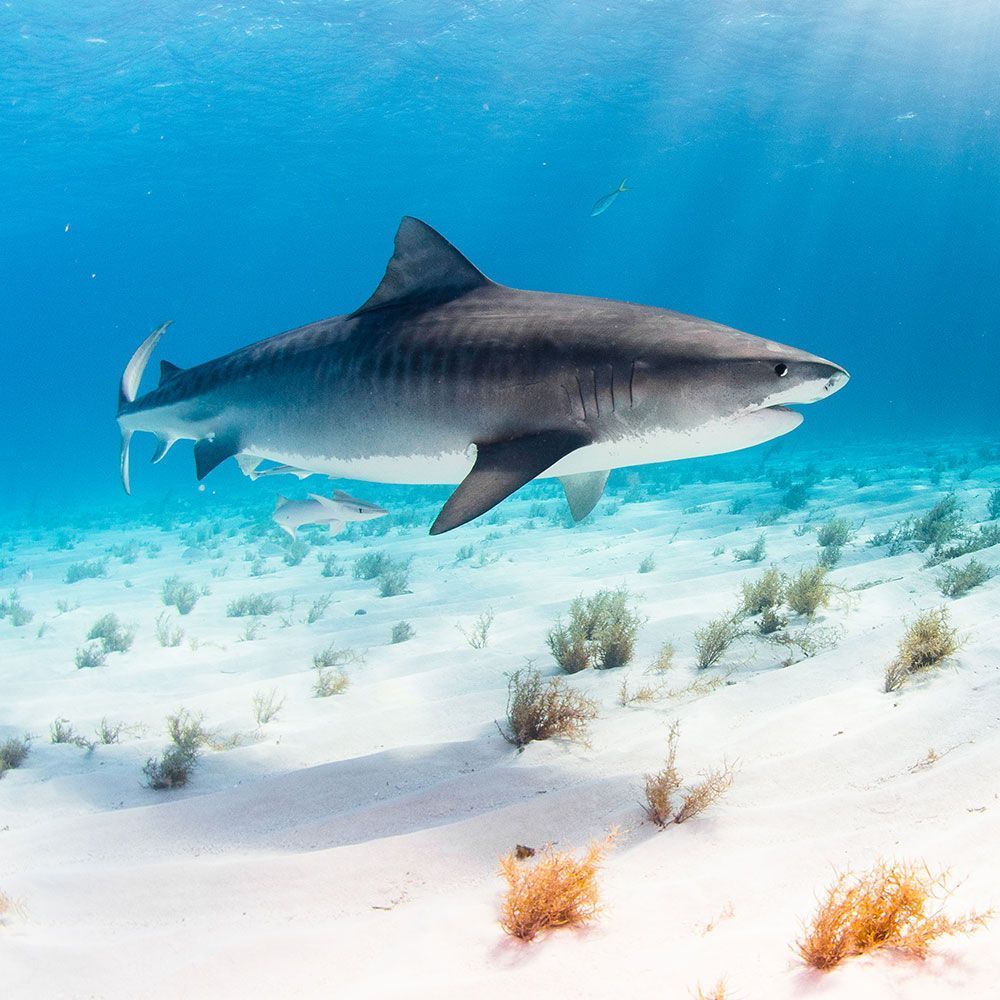
This ground shark species of the Galeocerdonidae family is an extremely aggressive carnivorous macropredator with a preference for sea turtles, birds, seals, and other sharks.
The “Nearly Threatened” Tiger shark is found in tropical and temperate oceans like the islands of the central Pacific Ocean, Japan, India, Indonesia, Africa, the Mediterranean Sea, Australia, and New Zealand. But it prefers to stay in deep waters.
It’s known to grow as big as 24 ft and 3.1 tons (6,200 lbs) off the Australian coast.
It’s usually popular as a slow and lazy swimmer, but when necessary, it can swim pretty fast. It is one of the best swimmers of carcharhinid sharks.
6. Beluga Sturgeon (Huso huso)
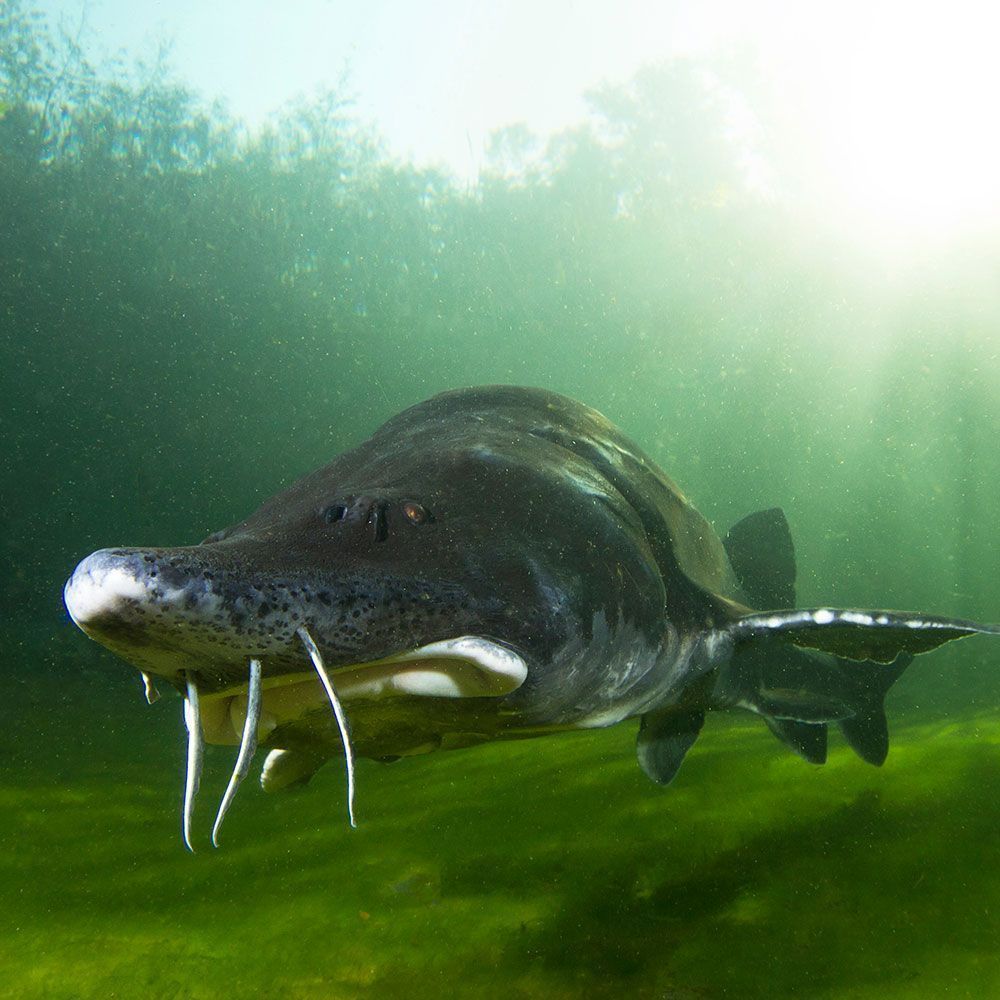
This non-gregarious, piscivorous sturgeon has an elongated grey/blue/brown/white mix-colored body covered in denticles, a hump, a long snout, bony armor, and a heterocercal tail.
The “Critically Endangered” species of the Acipenseridae family holds a maximum size and weight of 23.6 ft and 1.73 tons (3,460 lbs). The sighting happened in Volga estuary, 1827. It also holds the place of the largest freshwater fish in the world.
The harmless-to-mankind and shy fish is endemic to the Black Sea, the Sea of Azov, and the Caspian Seas.
Out of all sturgeons, this one migrates the most upstream to spawn. But the Iron Gates dams obstruct this activity.
7. Great White Shark (Carcharodon carcharias)
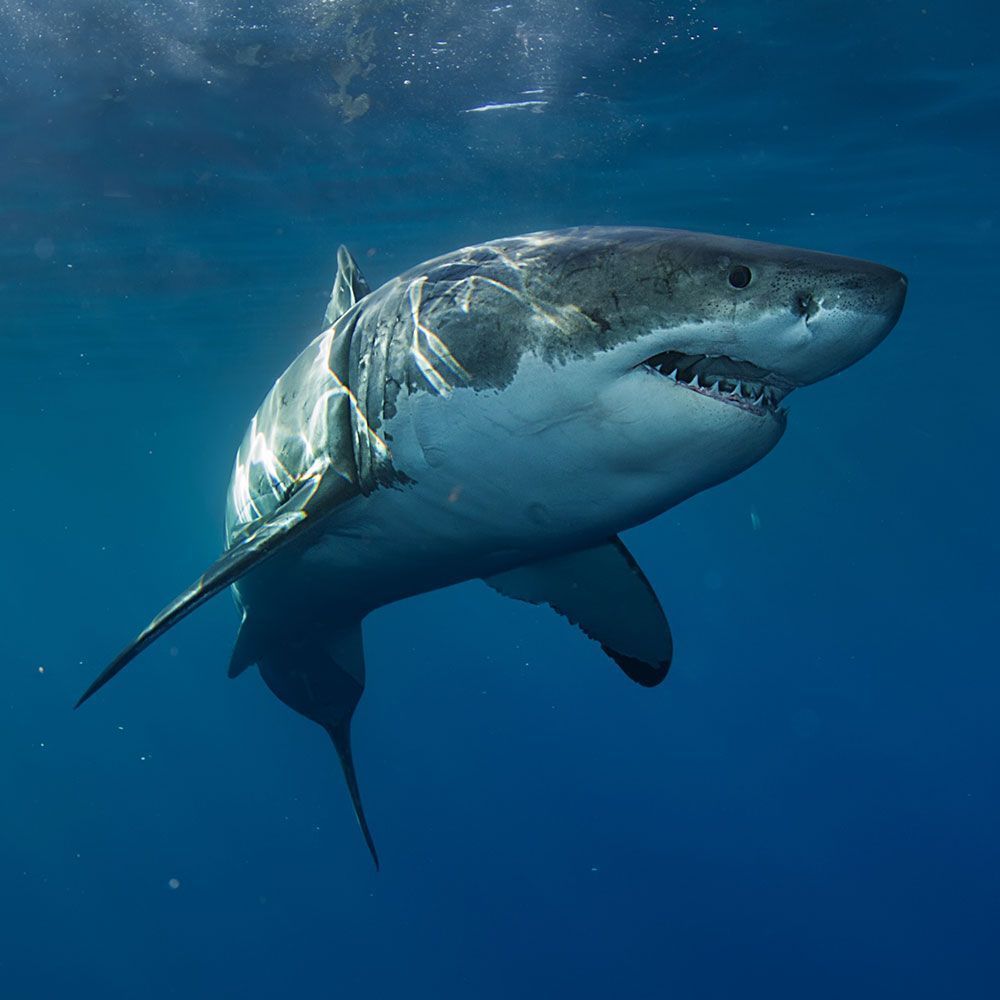
The highly wary and stealthy carnivorous predator shark from the Lamnidae family holds a record size and weight of 21 ft and 3.18-3.32 tons (7,000-7,328 lbs) – found in Cuba (1945).
Great white sharks are torpedo-shaped, grey, brown, or blue on top and white below, have conical snouts, serrated teeth, large black eyes, prominent keel at the base, and crescent-shaped tails.
This “Critically Endangered” epipelagic species is highly migratory and spotted in a variety of temperate and subtropical regions, offshore pelagic, and near-shore coastal regions.
Specifically found around the northeast US, California, South Africa (especially Long Island), Chile, Oceania, Japan, Sea of Marmara, and Bosphorus.
The warm-blooded shark is extremely intelligent and curious. It often displays complicated social behaviors.
8. Reef Manta Ray (Mobula alfredi)
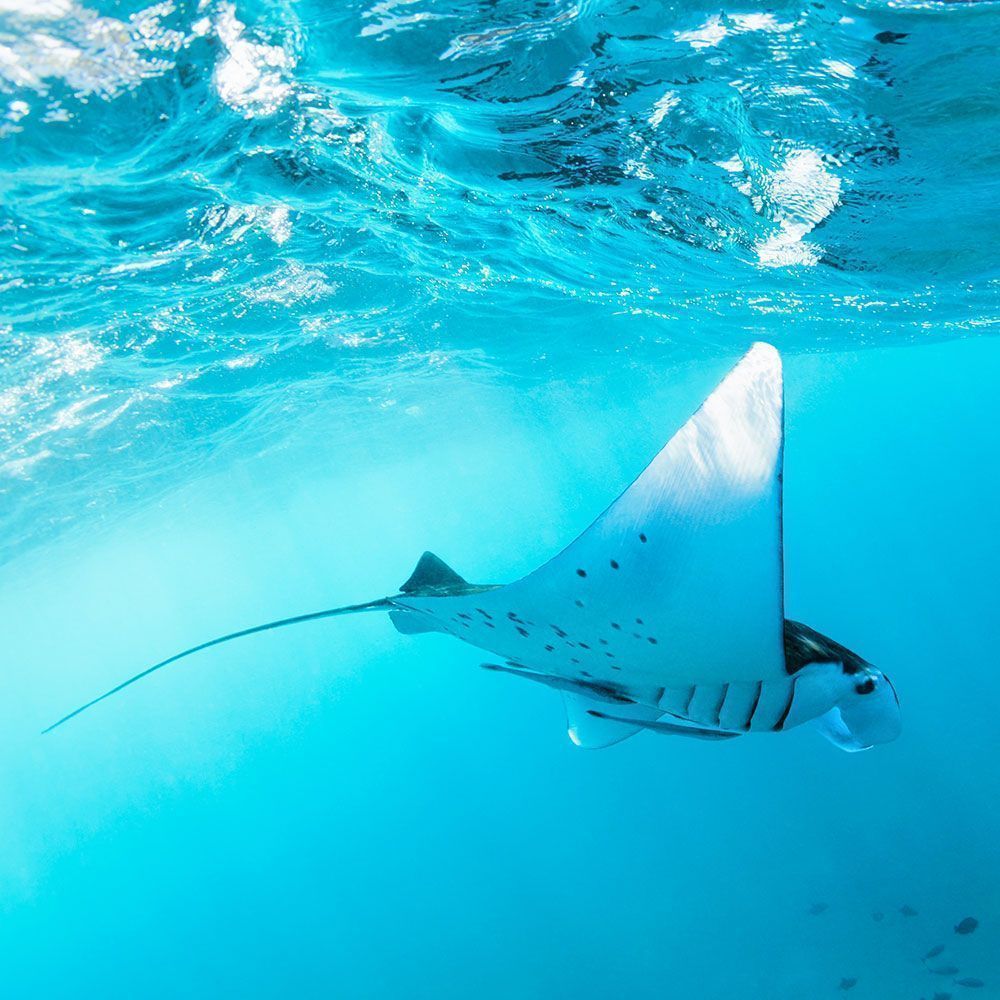
The tiny-plankton-eating carnivorous reef manta ray of the Mobulidae family flaunts a dorsoventrally flat body with triangular pectoral fins, which have forward extensions called cephalic fins.
The “Vulnerable” and gentle giant has a black top with white Y-shaped white marks and a white ventral side.
With an 18 ft disc size, this is the second largest manta ray alive. Not for this specific specimen, but the highest recorded weight for this manta ray is 1.4 tons (1270 lbs).
It’s found in both tropical and subtropical regions of the East-Atlantic and Indo-Pacific Oceans. You may also notice it in the coastal regions of Fiji, Hawaii, Bali, French Polynesia, Maldives, Philippines, Australia, and Mozambique.
This iconic manta ray has an escape speed of 24 km/h (15 miles/hour) when it encounters danger.
9. Atlantic Blue Marlin (Makaira nigricans)

The rare and solitary long-billed stout marlin is round in cross-section and has elongated bony scales. It has a blue-black dorsal and silver-white ventral side with multiple pale cobalt stripes of little dots.
The “Vulnerable” aggressive marlin of the Istiophoridae family is popular for hunting by stabbing and slashing predators with its bill at high speed.
The greatest size of Atlantic blue marlin noticed was 16.4 ft and 0.9 ton (1800 lbs).
Other than the Atlantic Ocean, it’s also spotted in temperate regions of both hemispheres. It’s seen in the Gulf of Mexico, around the waters of Caribbean islands, Bahamas, Venezuela, the Virgin Islands, and West Africa.
While preying at high speed, the marlin increases its speed by streamlining its body. This is done by folding its first dorsal, first anal, and all pectoral fins into its fin grooves.
10. Black Marlin (Istiompax indica)
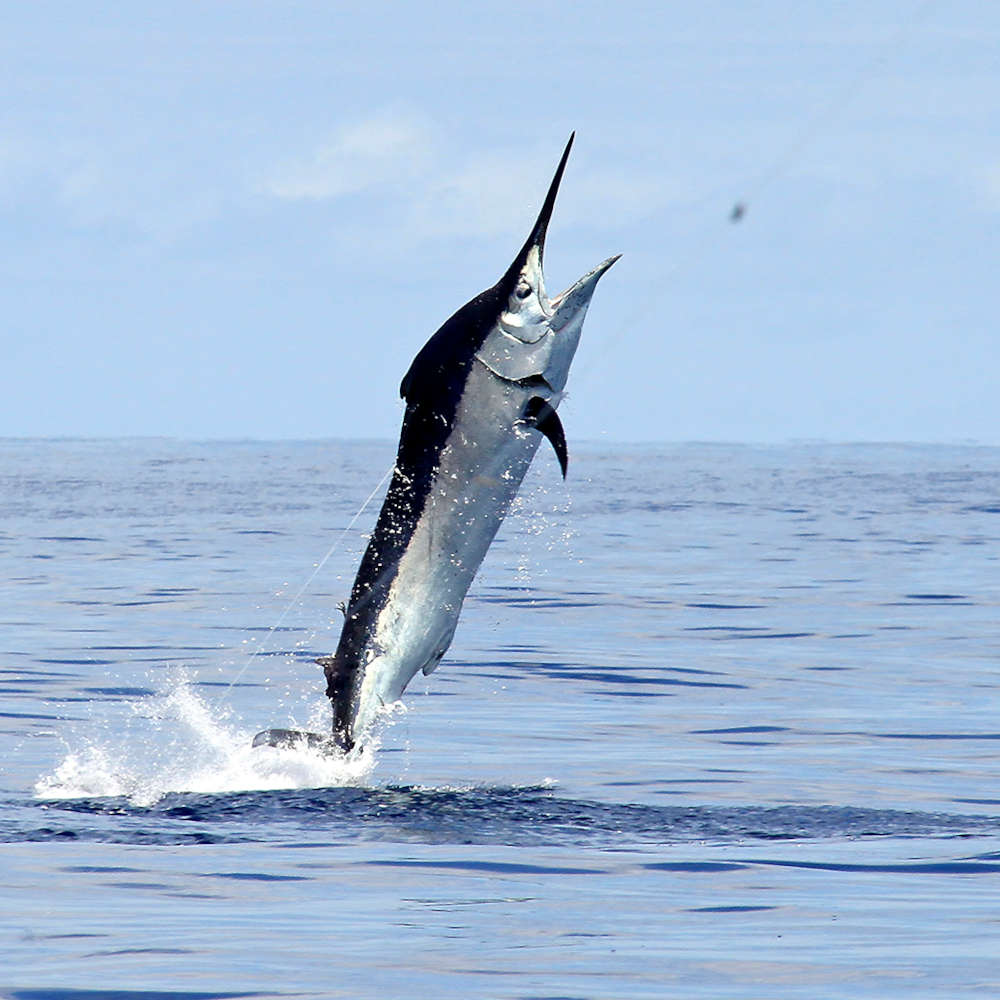
Again, from the Istiophoridae family, the solitary black marlin made it to this list of the top ten. This solid black-colored, short-billed marlin flaunts rigid pectoral fins that can only tilted slightly.
The primarily piscivorous predatory marlin usually swims about the Indo-Pacific subtropical and tropical regions and rarely gets spotted in the Atlantic Ocean.
The biggest of this species is found to be 15 ft 3 in long and 0.83-1 ton (1,650-2000 lbs).
Black marlins have a bad rap for dragging Maldivian fishing boats since ancient times until it got exhausted. The fishermen then struggled to return home by sailing for hours.
A word from FishInAquarium
The knowledge of the biggest fish in the world seems so fascinating. It’s hard even to believe that there are such humongous and majestic creatures hidden underwater.
But it’s a shame to know about these beautiful creatures alone. So, share the article with your friends. Let them also bask in the beauty of each of these species. And if you’re interested, you guys can also travel the world to see some of them in person!
If you have further questions, drop an email, and we’ll get your queries answered!

